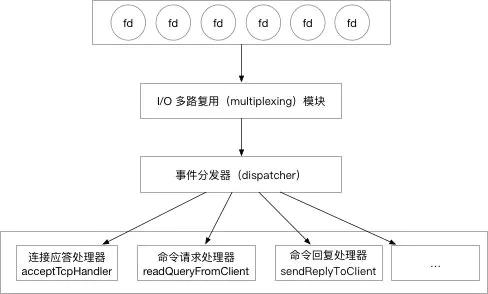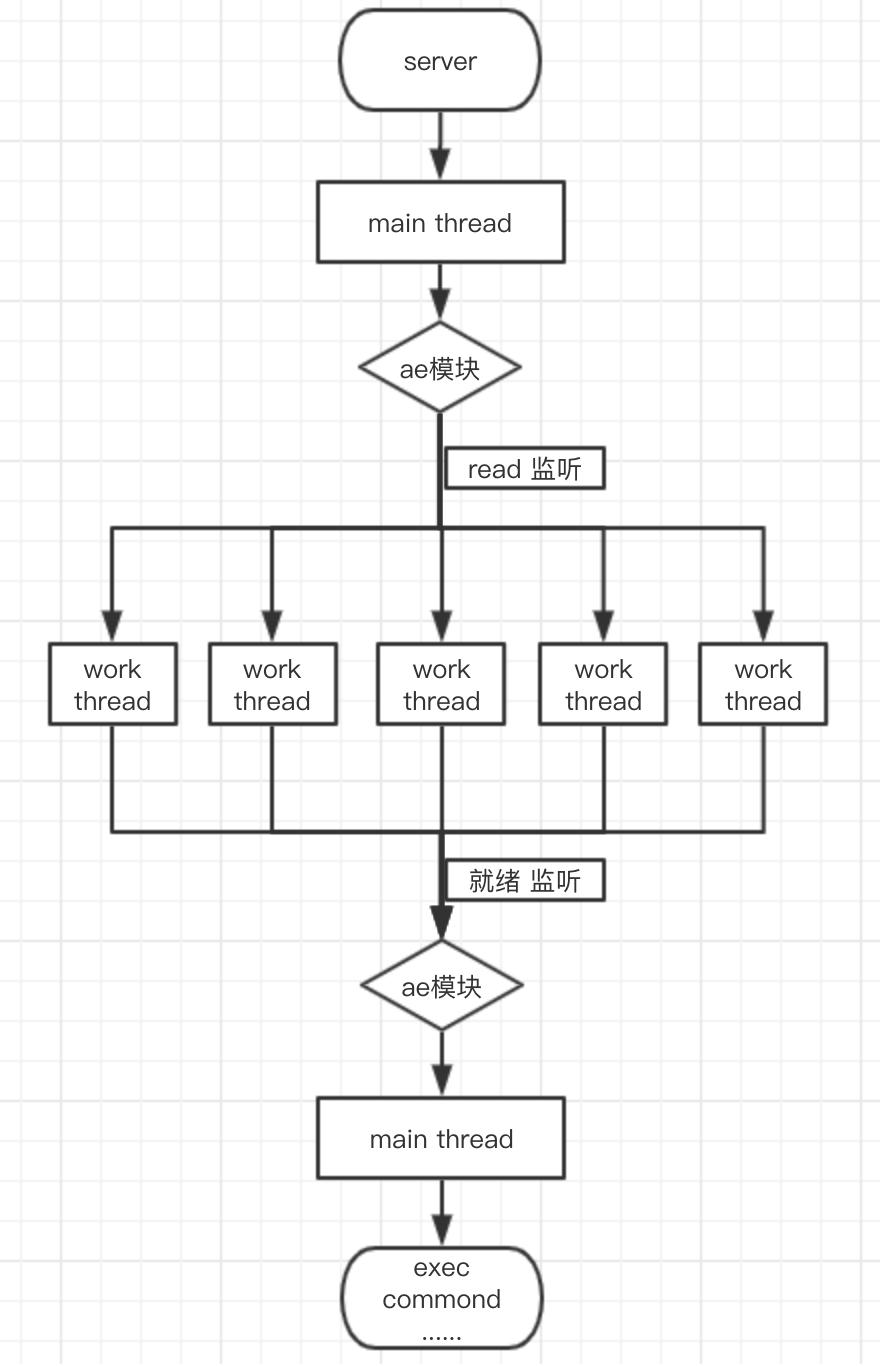Redis并发
- IO多路复用;
- 后台线程;
- 多线程;
1、IO多路复用
Redis采用单线程IO多路复用来实现高并发,即注明的Reactor单线程模式。具体的可以看我之前的文章: Java的NIO及Netty 。
Redis的IO多路复用机制可以选择使用很多种,比如select,epoll,kqueue,evport等。关于IO多路复用的可以参考这篇文章: 并发编程之I/O多路复用及几种I/O模式

接下来看看Redis的实现。先看启动吧,即src/server.c的main函数。这个函数会进行环境设置、初始化参数、数据恢复等等一系列操作。
int main(int argc, char **argv) {
struct timeval tv;
int j;
char config_from_stdin = 0;
initServer();
......
moduleInitModulesSystemLast();
moduleLoadFromQueue();
ACLLoadUsersAtStartup();
InitServerLast();
loadDataFromDisk();
aeMain(server.el);
aeDeleteEventLoop(server.el);
return 0;
}initServer创建了事件循环,并创建了两种事件,一个是文件事件,一个是定时事件。定时事件主要用于处理后台任务。
server.el = aeCreateEventLoop(server.maxclients+CONFIG_FDSET_INCR);
/* Create the timer callback, this is our way to process many background
* operations incrementally, like clients timeout, eviction of unaccessed
* expired keys and so forth. */
if (aeCreateTimeEvent(server.el, 1, serverCron, NULL, NULL) == AE_ERR) {
serverPanic("Can't create event loop timers.");
exit(1);
}
/* Create an event handler for accepting new connections in TCP and Unix
* domain sockets. */
for (j = 0; j < server.ipfd_count; j++) {
if (aeCreateFileEvent(server.el, server.ipfd[j], AE_READABLE,
acceptTcpHandler,NULL) == AE_ERR)
{
serverPanic(
"Unrecoverable error creating server.ipfd file event.");
}
}循环事件创建过程:
aeEventLoop *aeCreateEventLoop(int setsize) {
aeEventLoop *eventLoop;
int i;
monotonicInit(); /* just in case the calling app didn't initialize */
if ((eventLoop = zmalloc(sizeof(*eventLoop))) == NULL) goto err;
eventLoop->events = zmalloc(sizeof(aeFileEvent)*setsize);
eventLoop->fired = zmalloc(sizeof(aeFiredEvent)*setsize);
if (eventLoop->events == NULL || eventLoop->fired == NULL) goto err;
eventLoop->setsize = setsize;
eventLoop->timeEventHead = NULL;
eventLoop->timeEventNextId = 0;
eventLoop->stop = 0;
eventLoop->maxfd = -1;
eventLoop->beforesleep = NULL;
eventLoop->aftersleep = NULL;
eventLoop->flags = 0;
if (aeApiCreate(eventLoop) == -1) goto err;
/* Events with mask == AE_NONE are not set. So let's initialize the
* vector with it. */
for (i = 0; i < setsize; i++)
eventLoop->events[i].mask = AE_NONE;
return eventLoop;
err:
if (eventLoop) {
zfree(eventLoop->events);
zfree(eventLoop->fired);
zfree(eventLoop);
}
return NULL;
}创建文件事件:
int aeCreateFileEvent(aeEventLoop *eventLoop, int fd, int mask,
aeFileProc *proc, void *clientData)
{
if (fd >= eventLoop->setsize) {
errno = ERANGE;
return AE_ERR;
}
aeFileEvent *fe = &eventLoop->events[fd];
if (aeApiAddEvent(eventLoop, fd, mask) == -1)
return AE_ERR;
fe->mask |= mask;
if (mask & AE_READABLE) fe->rfileProc = proc;
if (mask & AE_WRITABLE) fe->wfileProc = proc;
fe->clientData = clientData;
if (fd > eventLoop->maxfd)
eventLoop->maxfd = fd;
return AE_OK;
}
至此,Server初始化基本完成。
接着执行aeMain过程,传入的时间循环:
void aeMain(aeEventLoop *eventLoop) {
eventLoop->stop = 0;
while (!eventLoop->stop) {
aeProcessEvents(eventLoop, AE_ALL_EVENTS|
AE_CALL_BEFORE_SLEEP|
AE_CALL_AFTER_SLEEP);
}
}
aeProcessEvents处理各种事件。文件事件会调用acceptTCPHandler.此外也会调用beforeSleep.
int aeProcessEvents(aeEventLoop *eventLoop, int flags)
{
int processed = 0, numevents;
/* Nothing to do? return ASAP */
if (!(flags & AE_TIME_EVENTS) && !(flags & AE_FILE_EVENTS)) return 0;
/* Note that we want call select() even if there are no
* file events to process as long as we want to process time
* events, in order to sleep until the next time event is ready
* to fire. */
if (eventLoop->maxfd != -1 ||
if (eventLoop->beforesleep != NULL && flags & AE_CALL_BEFORE_SLEEP)
eventLoop->beforesleep(eventLoop);
for (j = 0; j < numevents; j++) {
aeFileEvent *fe = &eventLoop->events[eventLoop->fired[j].fd];
/* Fire the writable event. */
if (fe->mask & mask & AE_WRITABLE) {
if (!fired || fe->wfileProc != fe->rfileProc) {
fe->wfileProc(eventLoop,fd,fe->clientData,mask);
fired++;
}
}
/* If we have to invert the call, fire the readable event now
* after the writable one. */
if (invert) {
fe = &eventLoop->events[fd]; /* Refresh in case of resize. */
if ((fe->mask & mask & AE_READABLE) &&
(!fired || fe->wfileProc != fe->rfileProc))
{
fe->rfileProc(eventLoop,fd,fe->clientData,mask);
fired++;
}
}
processed++;
}
}
1、acceptTCPHandler
void acceptTcpHandler(aeEventLoop *el, int fd, void *privdata, int mask) {
int cport, cfd, max = MAX_ACCEPTS_PER_CALL;
char cip[NET_IP_STR_LEN];
UNUSED(el);
UNUSED(mask);
UNUSED(privdata);
while(max--) {
cfd = anetTcpAccept(server.neterr, fd, cip, sizeof(cip), &cport);
if (cfd == ANET_ERR) {
if (errno != EWOULDBLOCK)
serverLog(LL_WARNING,
"Accepting client connection: %s", server.neterr);
return;
}
serverLog(LL_VERBOSE,"Accepted %s:%d", cip, cport);
acceptCommonHandler(connCreateAcceptedSocket(cfd),0,cip);
}
}2、然后执行acceptCommonHandler
static void acceptCommonHandler(connection *conn, int flags, char *ip) {
client *c;
char conninfo[100];
UNUSED(ip);
/* Create connection and client */
if ((c = createClient(conn)) == NULL) {
serverLog(LL_WARNING,
"Error registering fd event for the new client: %s (conn: %s)",
connGetLastError(conn),
connGetInfo(conn, conninfo, sizeof(conninfo)));
connClose(conn); /* May be already closed, just ignore errors */
return;
}
/* Last chance to keep flags */
c->flags |= flags;
/* Initiate accept.
*
* Note that connAccept() is free to do two things here:
* 1. Call clientAcceptHandler() immediately;
* 2. Schedule a future call to clientAcceptHandler().
*
* Because of that, we must do nothing else afterwards.
*/
if (connAccept(conn, clientAcceptHandler) == C_ERR) {
char conninfo[100];
if (connGetState(conn) == CONN_STATE_ERROR)
serverLog(LL_WARNING,
"Error accepting a client connection: %s (conn: %s)",
connGetLastError(conn), connGetInfo(conn, conninfo, sizeof(conninfo)));
freeClient(connGetPrivateData(conn));
return;
}
}3、创建连接客户端
client *createClient(connection *conn) {
client *c = zmalloc(sizeof(client));
/* passing NULL as conn it is possible to create a non connected client.
* This is useful since all the commands needs to be executed
* in the context of a client. When commands are executed in other
* contexts (for instance a Lua script) we need a non connected client. */
if (conn) {
connNonBlock(conn);
connEnableTcpNoDelay(conn);
if (server.tcpkeepalive)
connKeepAlive(conn,server.tcpkeepalive);
connSetReadHandler(conn, readQueryFromClient);
connSetPrivateData(conn, c);
}
selectDb(c,0);
uint64_t client_id;
//每个客户端唯一的id
atomicGetIncr(server.next_client_id, client_id, 1);
c->id = client_id;
c->resp = 2;
c->conn = conn;
.......
initClientMultiState(c);
return c;
}
上面首先创建了一个读事件
connSetReadHandler(conn, readQueryFromClient);
4、从客户端读
readQueryFromClient
最终会调用processCommand执行命令:
int processCommandAndResetClient(client *c) {
int deadclient = 0;
server.current_client = c;
if (processCommand(c) == C_OK) {
commandProcessed(c);
}
if (server.current_client == NULL) deadclient = 1;
server.current_client = NULL;
/* performEvictions may flush slave output buffers. This may
* result in a slave, that may be the active client, to be
* freed. */
return deadclient ? C_ERR : C_OK;
}
2、后台线程
自Redis4.0之后,Redis增加了异步线程的支持,使得一些比较耗时的任务可以在后台异步线程执行,不必再阻塞主线程。之前del和flush等都会阻塞主线程,现在的ulink,flushall flushdb等操作都不会再阻塞。
异步线程是通过Redis的bio实现,即Background I/O。
Redis在启动时,在后台会初始化三个后台线程。
void InitServerLast() {
bioInit();
initThreadedIO();
set_jemalloc_bg_thread(server.jemalloc_bg_thread);
server.initial_memory_usage = zmalloc_used_memory();
}bioInit就是具体启动后台线程过程。启动的线程主要包括:
#define BIO_CLOSE_FILE 0 /* Deferred close(2) syscall. */
#define BIO_AOF_FSYNC 1 /* Deferred AOF fsync. */
#define BIO_LAZY_FREE 2 /* Deferred objects freeing. */即关闭文件描述佛的,AOF持久化的,以及惰性删除。这三个线程时完全独立的,互不干涉。每个线程都会有一个工作队列,用于生产和消费任务。在添加和移除队列中都会加锁,防止并发问题。
for (j = 0; j < BIO_NUM_OPS; j++) {
void *arg = (void*)(unsigned long) j;
if (pthread_create(&thread,&attr,bioProcessBackgroundJobs,arg) != 0) {
serverLog(LL_WARNING,"Fatal: Can't initialize Background Jobs.");
exit(1);
}
bio_threads[j] = thread;
}主线程负责把相关任务添加到对应线程的队列中。比如惰性删除的过程,即我们使用UNLINK,flushDB,flushall等命令时。
//添加任务到对应线程队列中,添加过程会加锁
void bioCreateBackgroundJob(int type, void *arg1, void *arg2, void *arg3) {
struct bio_job *job = zmalloc(sizeof(*job));
job->time = time(NULL);
job->arg1 = arg1;
job->arg2 = arg2;
job->arg3 = arg3;
pthread_mutex_lock(&bio_mutex[type]);
listAddNodeTail(bio_jobs[type],job);
bio_pending[type]++;
pthread_cond_signal(&bio_newjob_cond[type]);
pthread_mutex_unlock(&bio_mutex[type]);
}不要担心后台删除会出现幻读的问题,主线程首先会删除对应keyspace,接下来的命令都访问不了了。后台线程负责清理对象。看下具体代码“
int dbAsyncDelete(redisDb *db, robj *key) {
/* Deleting an entry from the expires dict will not free the sds of
* the key, because it is shared with the main dictionary. */
if (dictSize(db->expires) > 0) dictDelete(db->expires,key->ptr);
/* If the value is composed of a few allocations, to free in a lazy way
* is actually just slower... So under a certain limit we just free
* the object synchronously. */
//同步删除keyspace或者直接同步清除
dictEntry *de = dictUnlink(db->dict,key->ptr);
if (de) {
robj *val = dictGetVal(de);
size_t free_effort = lazyfreeGetFreeEffort(val);
/* If releasing the object is too much work, do it in the background
* by adding the object to the lazy free list.
* Note that if the object is shared, to reclaim it now it is not
* possible. This rarely happens, however sometimes the implementation
* of parts of the Redis core may call incrRefCount() to protect
* objects, and then call dbDelete(). In this case we'll fall
* through and reach the dictFreeUnlinkedEntry() call, that will be
* equivalent to just calling decrRefCount(). */
if (free_effort > LAZYFREE_THRESHOLD && val->refcount == 1) {
atomicIncr(lazyfree_objects,1);
bioCreateBackgroundJob(BIO_LAZY_FREE,val,NULL,NULL);
dictSetVal(db->dict,de,NULL);
}
}
/* Release the key-val pair, or just the key if we set the val
* field to NULL in order to lazy free it later. */
if (de) {
dictFreeUnlinkedEntry(db->dict,de);
if (server.cluster_enabled) slotToKeyDel(key->ptr);
return 1;
} else {
return 0;
}
}
接下来就是后台线程会从对应队列中取出任务执行:
void *bioProcessBackgroundJobs(void *arg) {
struct bio_job *job;
unsigned long type = (unsigned long) arg;
sigset_t sigset;
/* Check that the type is within the right interval. */
if (type >= BIO_NUM_OPS) {
serverLog(LL_WARNING,
"Warning: bio thread started with wrong type %lu",type);
return NULL;
}
switch (type) {
case BIO_CLOSE_FILE:
redis_set_thread_title("bio_close_file");
break;
case BIO_AOF_FSYNC:
redis_set_thread_title("bio_aof_fsync");
break;
case BIO_LAZY_FREE:
redis_set_thread_title("bio_lazy_free");
break;
}
3、多线程
上面已经说了。Redis主要采用单线程IO多路复用实现高并发。后来为了处理耗时比较长的任务,Redis4.0引入了BackGround I/O线程。本身Redis的瓶颈并不是在于CPU,而是内存和网络IO。在一定程度上通过扩容即可。但是业务量不断扩大时,网络IO的瓶颈就体现出来了。这个时候使用多线程处理还是挺香的,充分发挥多核的优势。Redis6.0引入了多线程。
不过,这里强调一点,Redis引入了多线程,但也仅仅是用来网络读写,Redis命令的操作还是通过主线程顺序执行。这主要是为了减少Redis操作的复杂度等方面。
上面再说启动Background IO时,说到了InitServerLast,里面有个initThreadedIO,这个就是初始化线程IO的过程。
初始化线程IO的实现:
void initThreadedIO(void) {
server.io_threads_active = 0; /* We start with threads not active. */
/* Don't spawn any thread if the user selected a single thread:
* we'll handle I/O directly from the main thread. */
if (server.io_threads_num == 1) return;
if (server.io_threads_num > IO_THREADS_MAX_NUM) {
serverLog(LL_WARNING,"Fatal: too many I/O threads configured. "
"The maximum number is %d.", IO_THREADS_MAX_NUM);
exit(1);
}
/* Spawn and initialize the I/O threads. */
for (int i = 0; i < server.io_threads_num; i++) {
/* Things we do for all the threads including the main thread. */
io_threads_list[i] = listCreate();
//第一个是主线程,创建完continue
if (i == 0) continue; /* Thread 0 is the main thread. */
/* Things we do only for the additional threads. */
//worker线程注册回调函数。
pthread_t tid;
pthread_mutex_init(&io_threads_mutex[i],NULL);
setIOPendingCount(i, 0);
pthread_mutex_lock(&io_threads_mutex[i]); /* Thread will be stopped. */
//创建线程,并注册回调函数IOThreadMain
if (pthread_create(&tid,NULL,IOThreadMain,(void*)(long)i) != 0) {
serverLog(LL_WARNING,"Fatal: Can't initialize IO thread.");
exit(1);
}
io_threads[i] = tid;
}
}看上面代码,第一个是主线程,其他的都是Worker Thread。
一个图形可以反映上面的实现:

看一下他是咋实现多线程处理的。
其实请求处理流程还是和上面的一致,只是在readQueryFromClient有所不同。
void readQueryFromClient(connection *conn) {
client *c = connGetPrivateData(conn);
int nread, readlen;
size_t qblen;
/* Check if we want to read from the client later when exiting from
* the event loop. This is the case if threaded I/O is enabled. */
if (postponeClientRead(c)) return;
...
}如果是开启了线程IO,PostoneClientRead会把时间加入到队列中,待主线程分配给工作线程执行。
/* Return 1 if we want to handle the client read later using threaded I/O.
* This is called by the readable handler of the event loop.
* As a side effect of calling this function the client is put in the
* pending read clients and flagged as such. */
int postponeClientRead(client *c) {
if (server.io_threads_active &&
server.io_threads_do_reads &&
!ProcessingEventsWhileBlocked &&
!(c->flags & (CLIENT_MASTER|CLIENT_SLAVE|CLIENT_PENDING_READ)))
{
c->flags |= CLIENT_PENDING_READ;
listAddNodeHead(server.clients_pending_read,c);
return 1;
} else {
return 0;
}
}接着,在beforeSleep中会调用处理函数,多线程处理read操作。
int handleClientsWithPendingReadsUsingThreads(void) {
if (!server.io_threads_active || !server.io_threads_do_reads) return 0;
int processed = listLength(server.clients_pending_read);
if (processed == 0) return 0;
if (tio_debug) printf("%d TOTAL READ pending clients\n", processed);
/* Distribute the clients across N different lists. */
listIter li;
listNode *ln;
listRewind(server.clients_pending_read,&li);
int item_id = 0;
while((ln = listNext(&li))) {
client *c = listNodeValue(ln);
int target_id = item_id % server.io_threads_num;
listAddNodeTail(io_threads_list[target_id],c);
item_id++;
}
/* Give the start condition to the waiting threads, by setting the
* start condition atomic var. */
io_threads_op = IO_THREADS_OP_READ;
for (int j = 1; j < server.io_threads_num; j++) {
int count = listLength(io_threads_list[j]);
setIOPendingCount(j, count);
}
/* Also use the main thread to process a slice of clients. */
listRewind(io_threads_list[0],&li);
while((ln = listNext(&li))) {
client *c = listNodeValue(ln);
readQueryFromClient(c->conn);
}
listEmpty(io_threads_list[0]);
/* Wait for all the other threads to end their work. */
while(1) {
unsigned long pending = 0;
for (int j = 1; j < server.io_threads_num; j++)
pending += getIOPendingCount(j);
if (pending == 0) break;
}
if (tio_debug) printf("I/O READ All threads finshed\n");
/* Run the list of clients again to process the new buffers. */
while(listLength(server.clients_pending_read)) {
ln = listFirst(server.clients_pending_read);
client *c = listNodeValue(ln);
c->flags &= ~CLIENT_PENDING_READ;
listDelNode(server.clients_pending_read,ln);
if (c->flags & CLIENT_PENDING_COMMAND) {
c->flags &= ~CLIENT_PENDING_COMMAND;
if (processCommandAndResetClient(c) == C_ERR) {
/* If the client is no longer valid, we avoid
* processing the client later. So we just go
* to the next. */
continue;
}
}
processInputBuffer(c);
}
/* Update processed count on server */
server.stat_io_reads_processed += processed;
return processed;
}
主线程阻塞等待所有的工作线程都完成之后,将数据一同
下面是work线程的主要处理逻辑:
void *IOThreadMain(void *myid) {
/* The ID is the thread number (from 0 to server.iothreads_num-1), and is
* used by the thread to just manipulate a single sub-array of clients. */
long id = (unsigned long)myid;
char thdname[16];
snprintf(thdname, sizeof(thdname), "io_thd_%ld", id);
redis_set_thread_title(thdname);
redisSetCpuAffinity(server.server_cpulist);
makeThreadKillable();
while(1) {
/* Wait for start */
for (int j = 0; j < 1000000; j++) {
if (getIOPendingCount(id) != 0) break;
}
/* Give the main thread a chance to stop this thread. */
if (getIOPendingCount(id) == 0) {
pthread_mutex_lock(&io_threads_mutex[id]);
pthread_mutex_unlock(&io_threads_mutex[id]);
continue;
}
serverAssert(getIOPendingCount(id) != 0);
if (tio_debug) printf("[%ld] %d to handle\n", id, (int)listLength(io_threads_list[id]));
/* Process: note that the main thread will never touch our list
* before we drop the pending count to 0. */
listIter li;
listNode *ln;
listRewind(io_threads_list[id],&li);
//处理读写
while((ln = listNext(&li))) {
client *c = listNodeValue(ln);
//如果是写,写入并返回给客户端
if (io_threads_op == IO_THREADS_OP_WRITE) {
writeToClient(c,0);
//读操作
} else if (io_threads_op == IO_THREADS_OP_READ) {
readQueryFromClient(c->conn);
} else {
serverPanic("io_threads_op value is unknown");
}
}
listEmpty(io_threads_list[id]);
setIOPendingCount(id, 0);
if (tio_debug) printf("[%ld] Done\n", id);
}
}
Redis也部分和Memcached的思想有类似,Memcached也是通过主线程IO多路复用接受连接,并通过一定算法分配到工作线程,这和Redis6的多线程类似。但是,最大最大的不同是,Redis的多线程只是为了处理网络读写,不负责处理具体业务逻辑,命令还是主线程顺序执行的。然而Memcached是Master线程把连接分配给Worker之后,Worker线程就负责把处理后续的所有请求,完全是多线程执行。Redis要想做到这一点,需要做的工作还有很多,尤其是线程安全方面。据说或许要逐步加Key-level的锁,肯定是不断地完善的。
参考资料:
The little-known feature of Redis 4.0 that will speed up your applications
微信分享/微信扫码阅读


